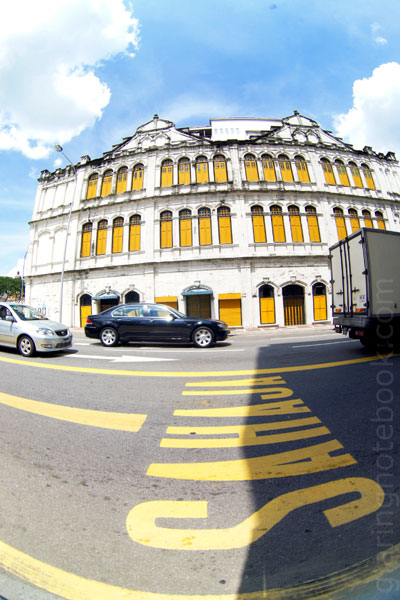
24th January 2009 – a little street shooting session followed by a talk!
Interestingly, there were a few interesting pairs of relatively lesser-owned lenses:
– 2 Peleng 8mm F3.5 M42 circular fisheyes
– 2 Sony Carl Zeiss Vario-Sonnar T* 24-70mm F2.8 ZA SSM lenses
– 2 Sony Carl Zeiss Sonnar T* 135mm F1.8 ZA lenses
– 2 Sony 70-200mm F2.8G SSM lenses

With the Carl Zeiss 135mm F1.8.

Here’s the Peleng with a 2x teleconverter, to make it a diagonal fisheye!

In really noisy conditions, I can walk past and snap unconspicuously from the hip.

The reflection on the wall has been boosted slightly.

Interestingly, the trademark Peleng flare does not show with the 2x teleconverter, it being outside the circle usually.

Then, we headed back to the Central Market Annexe Gallery for a talk by Sony Alpha Product Manager George Wong (who insists he is not representing Sony in the talk and thus makes no gear recommendations.)

Then it was Ted‘s turn to uh, make comments and critique on his own pictures. He also handed out his own autographed prints!

I wish I took this, or not. Ein took this. I normally strongly dislike slanted horizons but this one was done well in a very designer-ish fashion. This is a certain angle which is commonly used in website layouts.

Hoc Mun, on the amazing 1.2 meters minimum focus distance of the Sony 70-200mm F2.8G SSM.

I wish I took this. The building is framed smack center and the table is mostly spread across the bottom of the frame.

The Carl Zeiss 135mm F1.8 has a tendency to capture ambient, reflected light like the green of the table bouncing onto his face. This is at the lens’ amazing 72cm minimum focus distance, the closest of any 135mm prime lens ever.

Kenchill shows us how to work my Vivitar 24mm F2.0 DIY tilt-shift lens.

I wonder if photographers look like this when they are sleepwalking.

I tried to take a picture of Ted busy talking (with the cup of Milo settled, to illustrate how long he was talking) but he noticed too quickly and smiled. There goes my shot!

And after all that, we went down to Sony Style KLCC to check out the new infamously silver Sony 70-400mm F4-5.6G SSM, and the Sony Carl Zeiss Vario-Sonnar T* 16-35mm F2.8 ZA SSM. Let’s just say that we really don’t care if it’s silver or not, based on the insane image quality the lens gives.




















